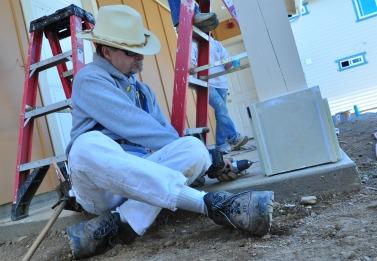 MVHS’s Habitat for Humanity helps build six-home project
MVHS’s Habitat for Humanity helps build six-home project
Three handprints lay embedded in the concrete of the house porch. Underneath, the owners’ names are written—BK, MJ, and JC. The marks are one of the things that personalize this house from the other six that Habitat for Humanity is building in Morgan Hill, Calif.
The small MVHS club of the same name has been a part of the volunteer force behind the project, including the likes of vice president and senior Albert Chao and teacher and club advisor Jon Stark.
MVHS’s Habitat for Humanity club has been around since 2001, but because officers continually graduated, the club has stuttered along since it began at school. There are roughly 15 members, yet few that actively work on the projects. HFH requires volunteers to be there for the entire day, from 9 a.m. to 3 p.m. There are tests and SATs and vacations over the summer, and with the Morgan Hill site being a solid 40-minute drive from school the number of members makes sense.
But once students go, they trade their pencils and paper for a hard hat. The safety gear is a must, and volunteers like theMVHS officers can use the simple white ones that HFH provides. Stark prefers to use his own, which looks like a cowboy hat.
“It’s break time,” a worker yelled from outside, who was most likely someone a part of the AmeriCorp program that assists with HFH.
“Alright… break time,” said AmeriCorp worker John. (His name was printed on his hat.) John nodded, stood up, and promptly hit his head on the bottom edge of the cabinet in the kitchen he was working in.
Again, hard hats are a must.
Chao was breaking down a battered, wooden platform with a hammer and crowbar when I found him. He was reluctant to talk, maybe because it was difficult to hear over the buzzing and hammering cacophony, or because he wanted to concentrate. Maybe because he just didn’t want to.
“Can you ask me later during the break?” Chao said. By break time, Chao had pulled apart most of the wood planks, leaving the rest of it to work on later. One of the AmeriCorp workers joked as all the workers gathered to rest, “Don’t fall in that general area,” waving his hand towards the platform on the ground with the nails sticking upward like a scene out of a bad Indiana Jones movie.
By break time, Chao had pulled apart most of the wood planks, leaving the rest of it to work on later. One of the AmeriCorp workers joked as all the workers gathered to rest, “Don’t fall in that general area,” waving his hand towards the platform on the ground with the nails sticking upward like a scene out of a bad Indiana Jones movie.
The work changes constantly, and later Chao traded his crowbar for a brush to finish painting a set of doors. Yet one of the constants of the HFH club is Stark. When the first officers had the idea to start the HFH club a decade ago, they come to Stark first.
“I was accessible. They knew me and I was there,” he said. “[Then they told me,] ‘Oh, by the way you have to come [work with us].’”
Since then, Stark has worked on dozens of houses in as many projects, even when he started out less passionately.
“You build a house here, you build a house there,” Stark said. “How does that make a difference? Then I realized it does. It’s transforming people by giving them a home. It’s not charity. It’s giving them hope, a chance.”
 The six-house project in Morgan Hill had begun, according to John, about 18 months earlier. While each house is at a slightly different stage of completion, it will not be much longer before the owners can move in. The buildings are done; they just have to be made functional. Volunteers tile kitchen counters or paint detail work on door edges. Sinks wait in boxes to be installed. The bathtubs were laid in, but the toilets were still missing.
The six-house project in Morgan Hill had begun, according to John, about 18 months earlier. While each house is at a slightly different stage of completion, it will not be much longer before the owners can move in. The buildings are done; they just have to be made functional. Volunteers tile kitchen counters or paint detail work on door edges. Sinks wait in boxes to be installed. The bathtubs were laid in, but the toilets were still missing.
One of the adult volunteers commented that as the AmeriCorp workers taught him how to finish the houses, it made him want to have a shopping spree at Home Depot so he could fix up his own home. Others learned how to cut tile using diamond-edged blades, trading tips on how to make them be just the right size.
Despite the smaller size of MVHS’ HFH club, the impact of the members’ actions grows, as does the organization. Within the 2011 year, HFH claims it will have a project in Cupertino. You build a house here, you build a house there, and eventually you build a community.








